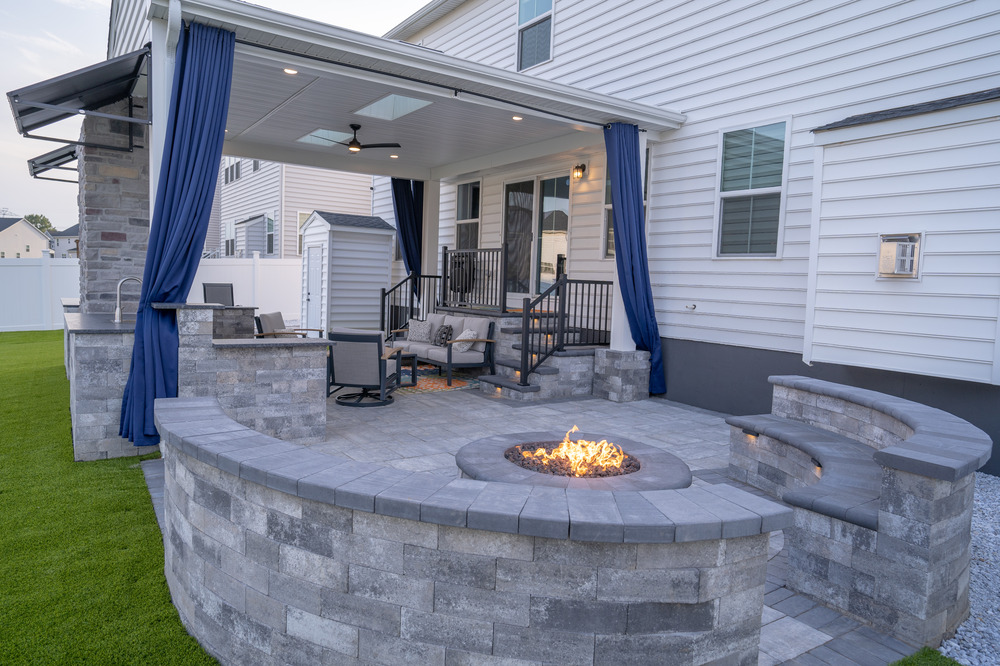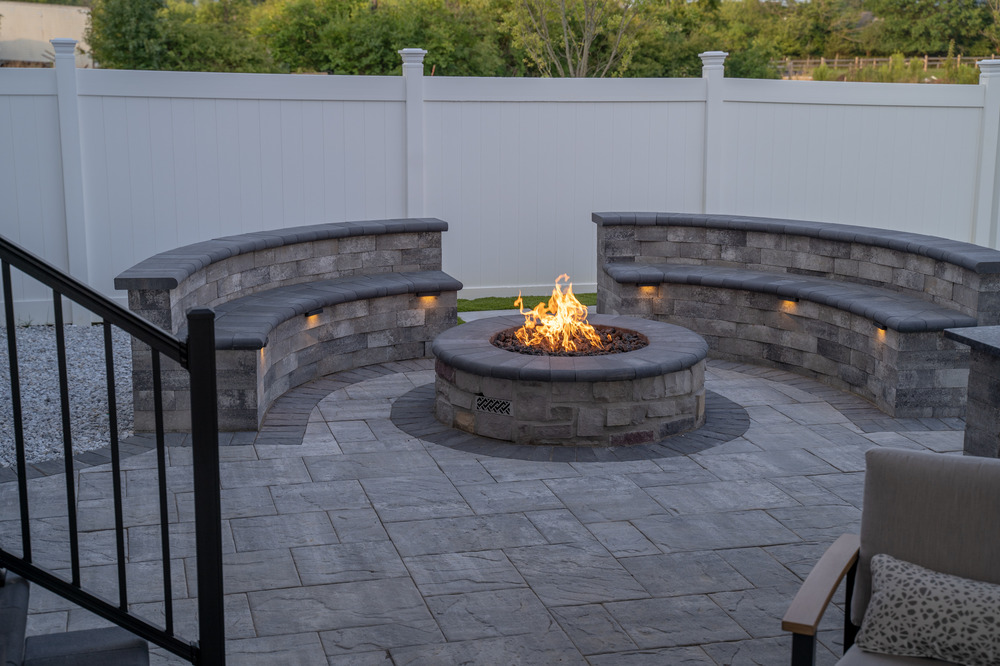When it comes to crafting the perfect outdoor escape, fire pits are more than just a source of warmth—they’re the heart of the gathering. Whether you’re looking to create a cozy corner for quiet nights or a stunning centerpiece for entertaining guests, knowing how to blend fire pits into your existing landscape design is essential for both function and curb appeal.
In this blog, we’ll walk you through the design principles, material options, and creative landscaping tips that help fire pits look like they’ve always belonged in your yard. We’ll also compare styles like gas vs. wood-burning and materials like stone vs. metal. By the end, you’ll be equipped with the inspiration and knowledge to bring your vision to life—right here in West Chester, PA.

Why Fire Pits Deserve a Place in Your Landscape Design
Before diving into the design strategies, let’s understand why fire pits have become a cornerstone in modern outdoor living:
- Year-Round Functionality: Fire pits provide heat for chilly nights, making your yard usable beyond summer.
- Social Focal Point: A well-placed fire pit becomes a gathering hub for family and friends.
- Versatile Aesthetic: From rustic stone circles to sleek gas tables, fire pits suit every design style.
- Property Value Boost: Professionally designed fire features can add value to your home’s landscape.
Evaluating Your Existing Landscape Design
To blend a fire pit into your current yard, start by taking inventory of what you already have:
- Hardscapes: Patios, decks, walkways—what structures dominate the space?
- Softscapes: Trees, shrubs, and garden beds that add color and texture.
- Architectural Style: Your home’s style should influence your fire pit’s material and shape.
- Traffic Flow: Consider how people move through your yard to avoid blocking key walkways or gathering areas.
A fire pit should feel like a natural extension—not a random addition. This means choosing placement, scale, and materials that complement what’s already in place.
Choosing the Right Fire Pit Style for Your Space
There’s no one-size-fits-all when it comes to fire pits. Your choice should reflect your lifestyle, design goals, and how you plan to use the space. Below are the most common styles:
1. In-Ground Fire Pits
- Best for: Natural landscapes or rustic backyard settings
- Design Tip: Use stone or brick for a seamless earth-integrated look.
- Landscape Compatibility: Great near gardens or woodland edges.
2. Above-Ground Fire Pits
- Best for: Patios, decks, and contemporary designs
- Design Tip: Choose materials that match or contrast your hardscape, like poured concrete or steel.
- Landscape Compatibility: Works well with formal or modern layouts.
3. Fire Pit Tables
- Best for: Outdoor dining and entertaining
- Design Tip: Choose a design with built-in seating or table space.
- Landscape Compatibility: Ideal for patios or transitional indoor-outdoor spaces.
4. Portable Fire Pits
- Best for: Flexibility and budget-conscious projects
- Design Tip: Add a gravel or stone pad to anchor the piece visually.
- Landscape Compatibility: Perfect for evolving layouts or renters.
Gas vs. Wood-Burning Fire Pits: Which is Right for You?
Each has its advantages—your lifestyle, local codes, and design preferences will guide your decision.
Gas Fire Pits
- Pros:
- Clean-burning with no smoke or ash
- Easy ignition and low maintenance
- Sleek, modern design compatibility
- Clean-burning with no smoke or ash
- Cons:
- Requires a gas line installation (higher initial cost)
- Lacks the crackle and scent of real wood
- Requires a gas line installation (higher initial cost)
Wood-Burning Fire Pits
- Pros:
- Traditional ambiance with smoky aroma and flame sound
- Generally more affordable
- Doesn’t require utilities
- Traditional ambiance with smoky aroma and flame sound
- Cons:
- Produces smoke and ash
- Requires storage for wood and more maintenance
- Produces smoke and ash
In West Chester, PA, where evenings can dip into cooler temperatures for much of the year, either option adds comfort and function. However, homeowners who prioritize convenience often lean toward gas, while those chasing a classic backyard experience prefer wood-burning.

Choosing Fire Pit Materials That Complement Your Landscape
Just like with hardscaping or patio design, the materials you choose for your fire pit will make or break how well it blends with the surroundings.
1. Natural Stone
- Pairs Well With: Traditional homes, rustic or wooded landscapes
- Look: Organic, timeless, and textural
- Pro Tip: Match the stone to existing retaining walls or garden edging.
2. Brick
- Pairs Well With: Colonial or historic-style homes
- Look: Warm and classic
- Pro Tip: Use the same brick type or color that appears on your home or walkways.
3. Concrete
- Pairs Well With: Modern and minimalist designs
- Look: Sleek and geometric
- Pro Tip: Consider tinted or stamped concrete to add custom texture.
4. Metal (Steel, Copper, Cast Iron)
- Pairs Well With: Industrial, eclectic, or contemporary outdoor spaces
- Look: Bold, durable, and often portable
- Pro Tip: Use metal accents elsewhere in the yard to tie the fire pit in (e.g., lighting fixtures, furniture legs).
Fire Pit Placement Tips for Seamless Integration
Where you place your fire pit determines how natural it feels in your space. Here are strategies to help it look like it’s always been there:
Center the Pit in a Gathering Zone
- Patios, pergolas, or open lawn spaces are ideal.
- Add built-in seating or surround it with outdoor furniture to define the space.
Frame It with Existing Landscape Elements
- Trees, shrubs, low stone walls, or garden beds help the fire pit feel nestled.
- Use curved lines in surrounding design to soften hard edges.
Mind the Wind and Safety Zones
- Avoid windy spots and always maintain a safe distance from buildings, fences, and trees.
- Local codes in Chester County typically recommend at least 10 feet of clearance around the fire pit.
Create Visual Pathways
- Use pavers, crushed gravel, or stepping stones to subtly guide people to the fire pit.
- Lighting along paths can enhance safety and nighttime ambiance.
Landscaping Around the Fire Pit: Softscapes & Hardscapes
The area surrounding the fire pit can either blend or clash—choose wisely.
Hardscaping Tips
- Use stone or concrete seating walls for a polished look.
- Consider adding a circular or square patio base beneath the pit.
- Tie materials together—if your patio is flagstone, use matching stone for the pit.
Softscaping Tips
- Add low-maintenance shrubs or ornamental grasses for texture.
- Use mulch or gravel to frame the area and create definition.
- Incorporate container plants for seasonal pops of color that can be changed easily.
Lighting and Accessories to Complete the Look
The fire pit is the star, but surrounding elements elevate the experience.
- String Lights or Uplights: Enhance evening ambiance without overpowering the fire glow.
- Built-in Benches or Lounge Chairs: Choose weatherproof seating that fits your landscape theme.
- Fire Tools and Storage: Tuck firewood or gas components into a nearby bench or stone box for a clean look.
- Outdoor Rugs or Side Tables: Add warmth and functionality underfoot and within reach.
Common Fire Pit Mistakes to Avoid
Even the most beautiful fire pit can fall flat if it disrupts the flow of your outdoor design. Watch for these common pitfalls:
- Wrong Scale: Oversized fire pits can dominate small yards, while tiny ones disappear in large spaces.
- Clashing Materials: A modern steel pit can look out of place in a garden full of natural stone.
- Neglecting Seating: A fire pit without cozy seating is rarely used.
- Ignoring Drainage: Water buildup can damage materials and make the pit unsafe.
Seasonal Maintenance and Care Tips
To keep your fire pit safe and looking good year-round:
- Cover When Not in Use: Invest in a waterproof cover.
- Clean Regularly: Remove ash, debris, or soot buildup.
- Inspect Gas Lines: If using a gas pit, check connections yearly.
- Winterize: In West Chester winters, store portable units and protect permanent ones from freeze damage.
Hiring a Pro for Seamless Integration
While fire pits can be a DIY project, hiring professionals like Couture Grounds ensures:
- Safe installation that meets local codes
- Aesthetic harmony with your existing design
- Access to custom materials and finishes
- Time-saving and value-boosting results
Call to Action: Get the Outdoor Oasis You Deserve
Ready to transform your backyard into a space you’ll use year-round? Whether you’re dreaming of a rustic stone fire pit or a sleek modern centerpiece, Couture Grounds can bring your vision to life.
Ready to elevate your backyard with a custom fire pit design? Call Couture Grounds today and discover why homeowners across Chester, Delaware, Montgomery, and Bucks counties trust us for expert outdoor living solutions.

